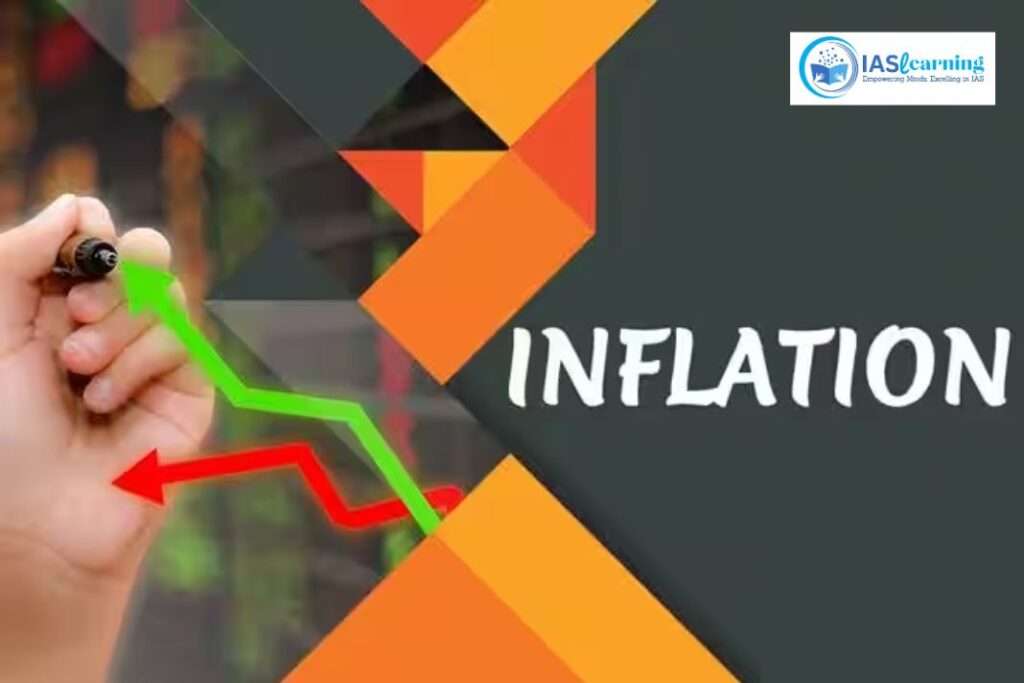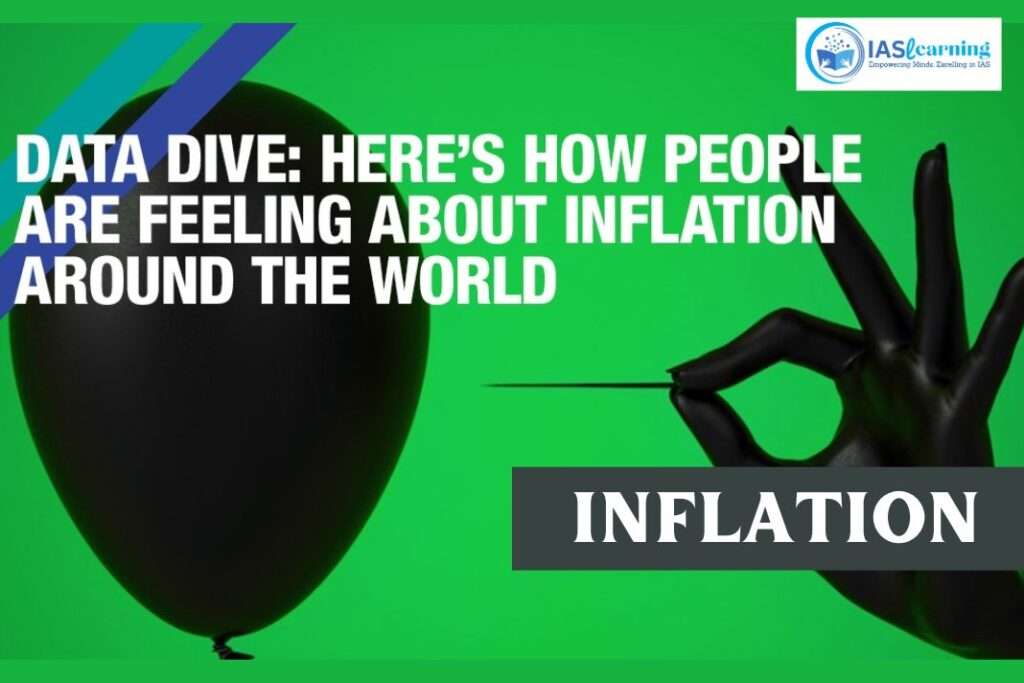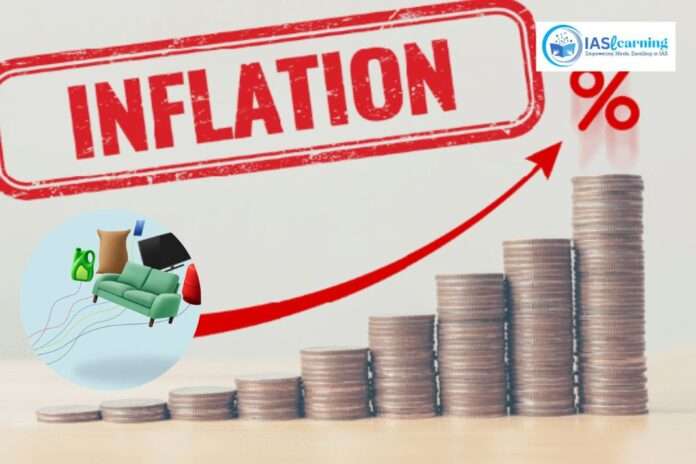Table of Contents
Introduction to Inflation
Inflation is a term used to describe the increase in the prices of commonly used goods and services, including items such as food, clothing, housing, recreation, transportation, and essential consumer products.
It is a measure of the average price change within a predefined basket of goods and services over a period of time. Conversely, when the price index of this basket experiences a rare decrease, it is referred to as ‘deflation.’ Inflation serves as an indicator of the diminishing purchasing power of a unit of a country’s currency and is typically expressed as a percentage

Types
Demand-Pull Inflation: Demand-pull inflation occurs when the overall demand for goods and services in the economy surpasses the available supply. In simpler terms, it happens when consumers and businesses are collectively buying more than what can be produced. This increased demand puts upward pressure on prices, leading to inflation.
Cost-Push Inflation: Cost-push inflation, on the other hand, occurs when there is a decrease in the aggregate supply of goods and services in the economy. This reduction in supply can result from various factors such as increased production costs, disruptions in the supply chain, or shortages of key resources. As the cost of production rises, businesses may pass those increased costs onto consumers in the form of higher prices, causing inflation.
Factors causing Inflation
Demand-Side Inflation: This type of inflation is driven by high demand coupled with low production or supply of various commodities, creating a gap between demand and supply. When demand outstrips supply, prices tend to rise due to increased consumption. Additionally, an increase in exports can undervalue the domestic currency, making imported goods more expensive and contributing to inflation. Excess circulation of money in the economy can also lead to inflation as money loses its purchasing power. When people have more money, they tend to spend more, further driving up demand and prices.
Cost-Push Inflation: Cost-push inflation results from a shortage of factors of production such as labor, land, and capital. Artificial scarcity created by hoarding can also contribute to this type of inflation. For example, rising prices of key commodities like Brent crude oil, vegetable oils, metals, and escalating international freight costs can increase the cost of production for businesses. When production costs go up, companies may pass these costs on to consumers in the form of higher prices, leading to cost-push inflation.

Indicators used to Measure Inflation
In India, inflation is primarily assessed using two main indices: the Wholesale Price Index (WPI) and the Consumer Price Index (CPI). These indices measure price changes at different levels of the economy.
Consumer Price Index (CPI): The CPI tracks the variation in the prices of goods and services that are purchased by Indian consumers for their personal use. It encompasses a wide range of items, including food, medical care, education, electronics, and more. CPI provides insight into the inflation experienced by the average consumer and is a key indicator for assessing retail-level price changes.
Wholesale Price Index (WPI): The WPI, on the other hand, monitors the fluctuations in the prices of goods and services that businesses sell to other smaller businesses for further resale or production. It focuses on the prices at the wholesale or producer level and includes items like raw materials, intermediate goods, and finished products. The WPI is essential for understanding price changes in the early stages of the supply chain.
Effects of Inflation in Indian Economy
1.When the prices of goods and services rise, the purchasing power of a unit of currency decreases. This means that with the same amount of money, people can buy fewer goods and services than before. This phenomenon directly impacts the cost of living in a country. When inflation is high, the cost of living also becomes higher because people need to spend more to maintain their standard of living.
2.High inflation can have several economic consequences. One of the notable effects is a deceleration in economic growth. When prices are rising rapidly, businesses may face increased production costs, and consumers may cut back on spending as they find it more expensive to purchase goods and services. This can lead to reduced economic activity and slower growth in the economy.
3.However, it’s important to note that a certain level of inflation is considered normal and even beneficial for an economy. Mild inflation encourages expenditure because it gives people an incentive to spend or invest their money rather than hoarding it. When prices are stable or deflation (falling prices) occurs, individuals may delay spending, anticipating that prices will be lower in the future. This can result in reduced economic activity and hinder growth. Therefore, a moderate level of inflation is often targeted by central banks to promote economic stability and growth.

Inflation targets in India
1.Inflation is monitored and measured by a central government authority responsible for implementing measures to ensure the smooth operation of the economy. In India, the Ministry of Statistics and Programme Implementation is tasked with measuring inflation.
2.The Reserve Bank of India (RBI), on the other hand, plays a pivotal role in controlling inflation through its Monetary Policy Committee (MPC). The RBI employs various tools to manage the money supply in the market, which has a direct impact on inflation rates. By adjusting interest rates, reserve requirements, and other monetary policy instruments, the RBI seeks to influence the level of inflation in the economy.
3.The Central Government in India has established specific inflation targets to guide economic policy. As of August 5, 2016, until March 31, 2021, the government set a target of 4 percent for Consumer Price Index (CPI) inflation. This target came with an upper tolerance limit of 6 percent and a lower tolerance limit of 2 percent. These targets provide a framework for the central government and the RBI to work together in managing inflation and maintaining price stability in the country’s economy.
Pros and Cons of Inflation Targeting in India
Inflation targeting is a monetary policy framework where a central bank sets a specific inflation rate target for the medium term and communicates this target to the public. The primary objective of inflation targeting is to achieve price stability, making it the central goal of monetary policy.
Pros of Inflation Targeting:
- Transparency and Accountability: Inflation targeting enhances transparency and accountability in monetary policy. By publicly announcing and committing to an inflation target, the central bank becomes more accountable to the public and policymakers for its actions.
- Medium/Long-Term Focus with Short-Term Flexibility: It allows central banks to focus on medium to long-term price stability goals while retaining some flexibility to address short-term economic fluctuations or crises.
- Anchoring Inflation Expectations: Inflation targeting helps anchor inflation expectations. When people are aware of the target, they tend to have lower inflation expectations. This can reduce wage and price pressures in the economy.
- Avoiding Boom and Bust Cycles: Inflation targeting can help prevent extreme boom and bust cycles in the economy by providing a stable framework for monetary policy.
- Cost Mitigation: It helps mitigate the economic costs of high inflation, such as increased uncertainty, reduced investment, loss of international competitiveness, and erosion of savings.
Cons of Inflation Targeting:
- Overemphasis on Inflation: Critics argue that inflation targeting places too much emphasis on controlling inflation at the expense of other important economic goals, such as reducing unemployment.
- Reduced Flexibility: In some situations, inflation targeting may limit the flexibility of central banks to respond to non-inflationary economic challenges. For example, it may not be well-suited to address supply bottlenecks or external shocks.
- Temporary Inflation Blips: Cost-push inflation, which results from factors like supply disruptions, can cause temporary spikes in inflation that are beyond the central bank’s control.
- Ineffectiveness in Removing Supply Bottlenecks: Inflation targeting alone cannot alleviate supply bottlenecks or shortages in the economy, which may require different policy measures.
- Short-Term Economic Impact: In the short run, pursuing strict inflation targets may have adverse effects on economic growth and employment, especially during economic downturns.

Government steps to Control Inflation in India
Controlling inflation has consistently been a priority for the Central Government, as outlined in the Economic Survey. Every year, the government implements a range of measures to address inflation, which are summarized in a dedicated chapter of the Economic Survey. Here are some of the steps the government has taken in previous years to control inflation:
- Issuing Advisories: The government issues advisories to state governments when necessary, urging them to take strict action against hoarding and black marketing. These advisories emphasize the enforcement of key acts such as the Essential Commodities Act, 1955, and the Prevention of Black-marketing and Maintenance of Supplies of Essential Commodities Act, 1980, particularly for commodities facing shortages.
- Regular Review Meetings: High-level review meetings on price and availability are conducted regularly. These meetings involve committees at various levels, including the Committee of Secretaries, Inter-Ministerial Committee, and the Price Stabilization Fund Management Committee. They assess the situation and plan strategies to stabilize prices.
- Higher Minimum Support Prices (MSP): The government announces higher MSP for certain agricultural products to encourage increased production. This strategy aims to enhance the availability of essential food items and contribute to price moderation.
- Price Stabilization Fund (PSF): The government implements the Price Stabilization Fund (PSF) to manage price volatility in agricultural commodities, such as pulses and onions. This fund is used to intervene in the market and stabilize prices when needed.
- Buffer Stock Enhancement: The government has approved the expansion of buffer stock reserves for pulses, significantly increasing them from 1.5 lakh metric tons to 20 lakh metric tons. This dynamic buffer stock is maintained to enable effective market intervention and price moderation.
- Distribution of Pulses: Pulses from the buffer stock are allocated to states and union territories for distribution through public distribution systems (PDS), the Mid-day Meal scheme, and to meet the requirements of the Army and Central Para-military Forces.
- Imposing Stock Limits: States and union territories are advised to impose stock limits on onions as a measure to manage supply and demand. This helps ensure the availability of onions and helps control price fluctuations. Import of onions is also facilitated to improve availability.
Way Forward
To control inflation in India, a multi-faceted approach is required, involving both monetary and fiscal policies as well as structural reforms. Here are some key strategies and ways forward to control inflation:
- Monetary Policy: The Reserve Bank of India (RBI) can use monetary policy tools to manage inflation. This includes adjusting interest rates, such as the repo rate, to influence borrowing costs and money supply. The RBI may raise interest rates to reduce demand and curb inflationary pressures.
- Supply-Side Measures: Addressing supply-side constraints is crucial. This involves improving agricultural productivity, reducing post-harvest losses, and investing in infrastructure for storage and distribution of agricultural products. Encouraging agricultural reforms, such as contract farming and market liberalization, can also help stabilize prices.
- Buffer Stocks: Maintaining strategic buffer stocks of essential commodities like food grains and pulses can act as a cushion against supply disruptions. These stocks can be released into the market when prices rise excessively.
- Effective Price Monitoring: Enhance the monitoring of prices and market conditions to identify early signs of inflationary pressures. Regularly reviewing and updating price data can help policymakers make informed decisions.
- Promote Competition: Encourage competition in various sectors of the economy to prevent monopolistic practices and price manipulation. A competitive market can help keep prices in check.
- Fiscal Policy: Use fiscal policy to manage demand. The government can adjust its spending and taxation policies to reduce fiscal deficits and lower overall demand in the economy.
- Rationalization of Taxes and Duties: Evaluate and rationalize taxes and duties on essential goods and services to prevent undue inflationary pressures. Reducing tax burdens on certain items can help control prices.
- Promote Productivity and Efficiency: Encourage industries to adopt efficient production methods, improve technology, and reduce waste. Increased productivity can help contain production costs and prevent price increases.
- Financial Inclusion: Promote financial inclusion to ensure that credit reaches marginalized sections of society. This can reduce their vulnerability to rising prices and support economic stability.
- Communication and Transparency: Maintain open communication with the public about inflation and government measures to control it. Transparent policies can help manage inflation expectations.
- Coordination: Ensure coordination between the central bank (RBI) and the government in addressing inflationary pressures. A collaborative approach is essential for effective policy implementation.
- Structural Reforms: Implement long-term structural reforms to improve the overall efficiency and competitiveness of the economy. This includes reforms in labor markets, land acquisition, and ease of doing business.
FAQs
1. What is inflation?
Inflation is the sustained increase in the general price level of goods and services in an economy over a period of time. It means that, on average, prices are rising, and the purchasing power of a currency is decreasing.
2. What causes inflation?
Inflation can be caused by various factors, including increased demand for goods and services (demand-pull inflation), rising production costs (cost-push inflation), changes in supply and demand for specific commodities, and monetary policy actions.
3. How is inflation measured?
Inflation is typically measured using various indices, such as the Consumer Price Index (CPI) and the Wholesale Price Index (WPI). These indices track changes in the prices of a basket of goods and services over time.
4. What are the effects of inflation?
Inflation can have both positive and negative effects. Positive effects may include encouraging spending and investment. Negative effects can include reduced purchasing power, uncertainty, and potential economic instability.
5. What is hyperinflation?
Hyperinflation is an extreme form of inflation where prices rise uncontrollably, often exceeding 50% per month. It can lead to the collapse of a country’s currency and severe economic disruptions.
6. How does inflation impact savings and investments?
Inflation erodes the purchasing power of money over time, which can reduce the real value of savings and fixed-rate investments. Investors often seek ways to protect their investments from inflation.
7. Can central banks control inflation?
Central banks, like the Federal Reserve in the United States or the Reserve Bank of India, use monetary policy tools to influence inflation. They can raise or lower interest rates and manage the money supply to control inflation to a certain extent.
8. What is the difference between core inflation and headline inflation?
Core inflation excludes volatile food and energy prices from the inflation calculation, focusing on the underlying trend in prices. Headline inflation includes all goods and services in the calculation.
9. How does inflation affect fixed-income individuals and retirees?
Fixed-income individuals and retirees may be particularly vulnerable to inflation, as their income remains constant while the cost of living rises. This can reduce their standard of living over time.
10. Is deflation the opposite of inflation? – Yes, deflation is the opposite of inflation. Deflation refers to a sustained decrease in the general price level, leading to an increase in the purchasing power of money.

